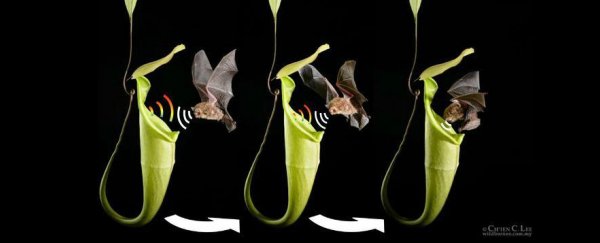Scientists have discovered that a species of carnivorous pitcher plant in Borneo has evolved a unique way of enticing bats to roost nearby. But the end goal isn't to eat the flying mammals - instead, Nepenthes hemsleyana stays nourished by digesting their falling droppings.
So in other words, a plant has worked out how to communicate with a mammal, just to encourage it to poop in its mouth.
The fascinating mechanism involves special reflector structures on the plants, which bounce bats' ultrasonic calls back at them, luring them to roost in the shade of their leaves.
"With these structures, the plants are able to acoustically stand out from their environments so that bats can easily find them," one of the researchers Michael Schöner, from the Ernst-Moritz-Arndt-University of Greifswald in Germany, told Jennifer Viegas over at Discovery News. "Moreover, the bats are clearly able to distinguish their plant partner from other plants that are similar in shape, but lack the conspicuous reflector."
Most pitcher plants survive by using slippery nectar to attract ants, termites and other insects onto the rim of their bucket-shaped leaf, where they slip into a pit of deadly digestive acids. Some species can devour up to 6,000 insects an hour.
But Schöner and his team noticed that one particular species in the Borneo jungle was living on nothing but bat droppings, and started wondering what the plant was doing differently to attract so many bats to roost nearby.
To work this out, the researchers used an artificial biomimetic bat head, which could record and play ultrasounds. This allowed them to test whether the pitcher plant was reflecting the bat's calls, and if so, where they were bouncing off from.
Publishing in Current Biology, they found that the plant has uniquely shaped back walls that perfectly reflect a bat's own call back to it. The team then confirmed this by showing that the mammals were more likely to roost on pitcher plants with their reflector structures intact - even when they were hidden - than plants without them.
"Carnivorous plants in general have already solved the problem of nutrient deficiency in a very unusual way by reversing the 'normal system' of animals feeding on plants," Schöner told Viegas. "It is even more astonishing that in the case of N. Hemsleyana, the system is taking a new turn."
"While N. Hemsleyana reduced many insect-attracting traits, it obviously exhibits some traits that are highly attractive for a species that provides the plants with nutrients without being digested by the plant itself," he added.
That's one pretty clever way to make sure you never run out of food.
